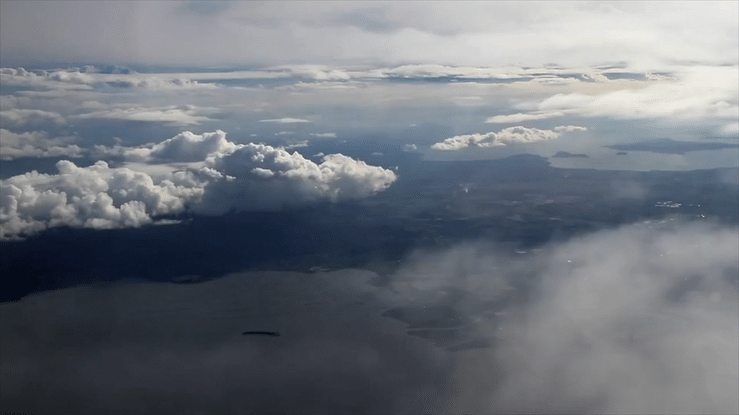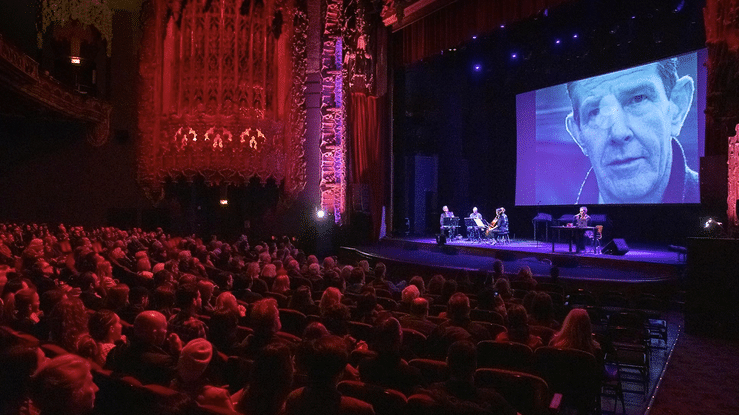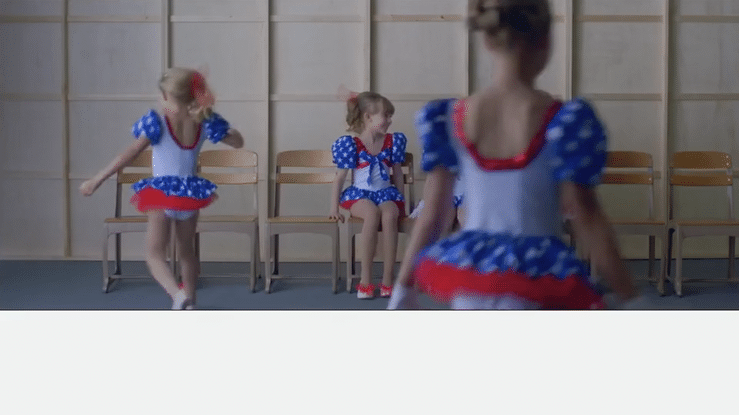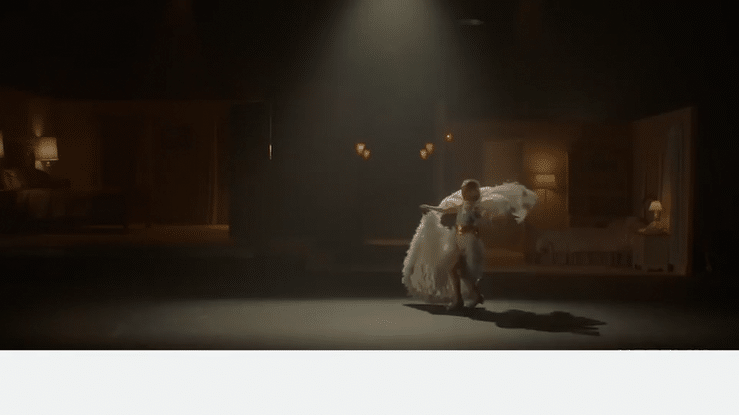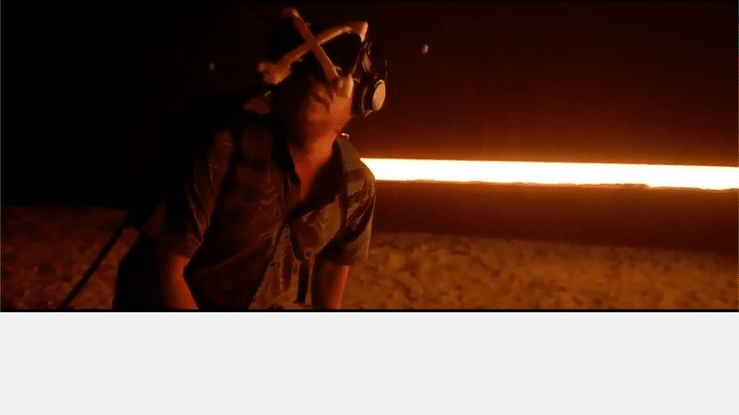States of Documentary: Funding and Programming
Roya Rastegar with Donald Young, Tabitha Jackson, and Hussain Currimbhoy
We are witnessing significant shifts in the field of contemporary documentary production, programming, and criticism. A clear expansion of new digital technologies and innovative formal approaches has been accompanied by the growth of film festivals that prioritize nonfiction programming. Feature length documentaries are garnering increased attention as marquee titles on streaming platforms. What is less clear are the relationships between recent formal and technological shifts in independent documentary, and the funding and distribution infrastructures that support them. Also up for debate is documentary’s evolving relationship to the aims of social justice.
In these three interviews, I engage three members of the film industry to think through these shifts together, what they might mean for documentary filmmaking, financing, formats, and audiences. Donald Young offers insight into what he calls the emerging “industry of documentary” and the dangers of narrowing the possibility of documentary to the glamor of premieres at prestigious film festivals, high profile distribution deals, and The Academy Awards. Tabitha Jackson reflects on the forms of documentary, on why she prefers the term “nonfiction,” and on the importance of making distinctions between documentary and journalism in a moment when facts are forged and the truth is a constant question. My discussion with Hussain Currimbhoy takes another turn to consider how virtual reality is laying the groundwork to radically transform the future sites and experiences of documentary spectatorship.
****
Donald Young
(Director of Programs, Center for Asian American Media)
Roya Rastegar
You’ve produced both documentaries and fiction films, you’ve overseen the national television broadcasts of over 150 projects, and have directed the programming at the Center for Asian American Media (CAAM) for over two decades now. What is the biggest shift you’ve seen in the infrastructures of funding for documentaries in the past decade?
Donald Young
Documentary, by and large, is a field formed on making society better. Traditionally, documentary came out of a place of telling the stories of the untold, revealing histories untold, putting a mirror in front of society. Now, on the one hand, documentary is thriving. There are many outlets. It is an exciting time where many communities are starting to find their voices. There are groups in the Asian American community, like A-DOC (Asian American Documentary Network), Brown Girls Doc Mafia, and Firelight Media Doc Fellows. Folks are redefining and rearticulating their desired place in this space. But it is an uphill battle.
RR
Why an uphill battle, at a time when there are so many outlets?
DY
Sometimes I joke that documentaries—the funding, distribution, production—are a system that has evolved backwards. In the 1970s and 80’s, there was such a daring pursuit of telling stories that would explicitly change society. Now, many people still want to change society—but many also want that Sundance premiere, Netflix acquisition, and then the Oscar run. It’s almost as if that’s the goal for every single filmmaker we see. When there is effectively one goal, everything else is seen as defeat. So then, what does it mean when you don’t achieve that? For example, we have been supporting a particular filmmaker who received grants from Sundance and Tribeca. She didn’t get picked up by any of the larger festivals that we thought she was tracking towards. She was really deflated. Each film has its own journey, but each aspiration now is frequently the same. She’s going to be premiering at a southern film festival and will more carefully design her path. She has to work harder to succeed, it won’t be as automatic. She’s getting picked up by a bunch of very well-respected regional festivals, but not the three or four industry based festivals that get your film the attention of these larger platforms. Now, she’ll just have to more actively craft that journey for her film. And it’s a great film, so she’ll ultimately be alright, but because she didn’t get into those high level festivals out right, she instantly felt beat up.
RR
What is the role of platforms in setting this rather singular path as a goal? Do you think that kind of mainstreaming of documentary means the work in the 1970s and 1980s was a success?
DY
For years, a lot of people thought documentary was equitable in front of and behind the camera. A profession that is so noble in nature, must be equitable by design! We can see now—with merging media platforms and new articulations of power structures—that this is clearly not the case. Filmmakers go to these super producers that have risen—places like Apple, Netflix, HBO, CNN, and others—because they are successful, reliable and do quality work that will deliver the results they want. These are filmmakers who have become really successful and have become mini-studios onto themselves.
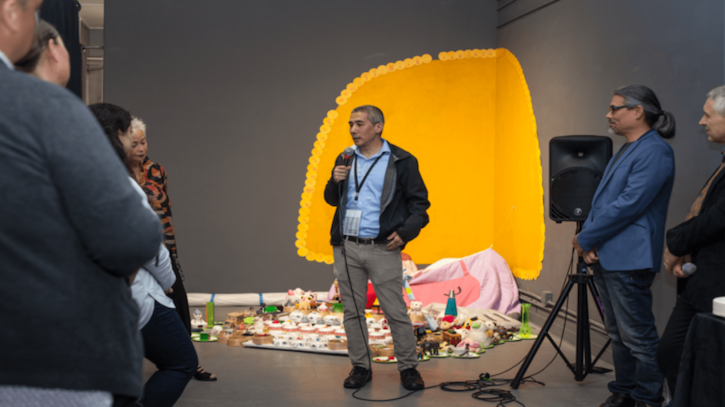 Donald Young at the Pacific Gateway project at CAAMFest in May 2018. Photo by Lucy Saephan, courtesy of
CAAM.
Donald Young at the Pacific Gateway project at CAAMFest in May 2018. Photo by Lucy Saephan, courtesy of
CAAM.
RR
In some ways, we can see this as a success, with the rise of super producers indicating a hunger for documentaries amongst audiences at large.
DY
It is great for documentary, but I’m not sure it’s great for the field. There is a tier-ing that didn’t exist before. Who is succeeding now, and who’s not? Who can play the game? In this funding/distribution atmosphere, it is really only the super producers who can thrive. I don’t say this resentfully. We do this in the grant making space—as both funders and producers—so we’re guilty of being part of this system. Diverse and women producers still have to scrape by every step of the way. So what does it mean when an ecosystem doesn’t attend to its own?
RR
It provides less space for discovery, less opportunity for new filmmakers who are not tested and proven.
DY
Yes, and also—it means documentaries are now an industry. This wasn’t always the case. But with these new platforms and the money that is going around, that’s what this is. For example—Steve James’ America To Me (2018) series was just acquired by Starz for $5 million. That’s a big acquisition. The industry of documentary is something we have to acknowledge now.
RR
It might be interesting to consider a tale of two origins for documentary. I’m thinking about the documentary The March (2013), which was commissioned by the US government, almost to serve as proof of racial equity and progress in the US. Amidst all these postcolonial movements around the world, the US funds and produces this film as a way to present itself as a progressive place, a rebuttal to the stories of racial injustice and violence in the US that are circulating around the world. So the question for me is: What are the kinds of films that get through the Sundance/Netflix/Academy gates, and what are the kinds of films and filmmakers that are still fighting for recognition, funding, distribution—equitability, as you call it?
DY
To your point, the distinction between propaganda versus documentary is in the eyes of the beholder. The investors, funders, high-wealth individuals, documentary studios, platforms, are looking for two pieces—either a really good story well told, or change-making narratives that could be very biased in their approach. And to some extent, some social issue funders want social change propaganda, and wear that with a badge of courage. We have a board member who is part of Impact Partners, which has an interesting, investment-based model where individuals invest in documentaries, instead of the traditional foundation or donor-based model. And they have become a documentary studio of sorts, and have proven an important structure for studio finance. They are effectively financing or commissioning what will be a major impact tool. But they still want a return on their investment. So what happens to documentaries under the equity investment model of funding? Surely, these investors aren’t doing it to make money, but still…
RR
…They definitely don’t want to lose money.
DY
Right. And financial return is one way they measure a true return on their investments. But also, it could very well be that if they have a film that goes to Sundance and has a terrible theatrical release, but gets critical acclaim and has real social impact, they could still very well see that as a positive return.
RR
Because private funders want a return on their investment—whether it is monetary or cultural.
DY
Exactly. Because it is ultimately a transaction. The return on investment is not just financial, it could also just be cultural. They can have a release, and it can do its work in the world, but through those higher profile platforms….(pauses) I mean, really, though, if rich people want to invest in films—that’s cool. (laughter)
RR
At this point, if rich people don’t invest in films, who else will?
DY
Oh absolutely, I think that’s a fair point.
RR
Because the government isn’t doing it. And we’re also at a moment where people who have great wealth are being vocal about their responsibility to society at large, in terms of redistributing that wealth through philanthropic means. Abigail Disney, for example, who has executive produced tons of great social issue-focused documentaries going back to Pray the Devil Back to Hell in 2008, has been especially vocal about this.
RR
What do you mean when you say transactional?
DY
I started in the field back in the 1990s. From what I can understand from the early 1980s to the mid 1990s, before the contracting of America and the real leveling off and cutting back of funding for arts institutions. Back in those days, I heard filmmakers say, “I had never made a film before and I got $150k to make a film. That’s the foundation of how I was able to become a filmmaker.” There were more fellowships for women filmmakers, public television was more committed, there were infrastructures for fellowships and learning. But now you have to prove your mettle: are you a worthwhile investment for a foundation, for a funder, or from an investor’s perspective? It’s a fair question for somebody providing resources: am I getting the return? I don’t think that’s an inappropriate ask. But I do believe it places a much higher burden on the filmmaker in terms of performing at certain metrics, going viral, getting the critical acclaim, the broadcast deals, and then, sharing all the backend. It has made the terrain of documentary filmmaking much more treacherous than it was years ago.
RR
In your estimation, is this because of the fundamental shift from public to private funding?
DY
I think it is a combination of that and of federal funders like CPB (Corporation for Public Broadcasting) needing to prove to taxpayers that they are creating social impact and changing communities, in order to justify their funding. There is the same amount of funding for individual filmmakers as there was fifteen years ago. ITVS (Independent Television Service), CAAM (Center for Asian American Media), and anybody in public television—Ford Foundation, MacArthur Foundation—we’re all giving about the same money we were giving twenty years ago to filmmakers. That’s just the nature of the beast.
RR
You are giving the same amount?
DY
Well, inflation is an added tension, so effectively it is a lot less to more filmmakers. ITVS has stayed at the same $11 million level for probably twenty years now.
RR
And on top of that, there’s even more filmmakers that money has to be spread around to.
DY
Yes, that’s right. And this dynamic changes the nature of expectation. If people got plenty of public funds to do whatever they wanted, probably the investors would have a different role in all this. Back in the day, you could make your $100k, your $50k film and get into Sundance, then get a theatrical release. But those days of being an undiscovered filmmaker who didn’t previously have a track record, and that funders would take a risk on—those days are over.
RR
Is this because the landscape for funding has become more institutionalized? So programmers and funders are hearing about films earlier—through pitching forums and the like?
DY
Right, we all eventually group fund. All of a sudden, a documentary gets seven or eight funders, or they get Impact Partners, or they get Sundance support. We all seem to find the same projects where you can do a theatrical, broadcast, or Oscar run—as opposed to what used to be issue-oriented and community driven. But the annual calendar, like in studio film production, really does drive decision-making.
RR
Do you still believe that social impact is possible through documentary filmmaking?
DY
Yes, but it has really evolved since CAAM first went about it. Because documentary has become an industry unto itself, in order to succeed, filmmakers and artists have had to figure that out accordingly. Documentaries are now an industry of social change. For us at CAAM, social impact is always the combination of the impact of a film—how can a film be used as a tool for positive social change and progress—and equity for the filmmakers behind the camera—a reflection of those aspirations. We’re always holding ourselves accountable for making the world better, as well as the world in which we work. We have a tricky situation where the umbrella term for Asian Americans is incredibly diverse in terms of ethnicities and languages, in addition to the classes and communities we live in across the country. We’re funded by public television, so there’s an additional level of accountability. We try to hold true to those standards, holding ourselves to those standards.
RR
How do you hold yourself accountable to those standards?
DY
Because we’re federally funded, we have a lot of annual and quarterly reporting that we have to do. Everything from the diversity of who we fund to the different platforms by which audiences are exposed—web or broadcast, community screenings and festivals—to awards received. We try to be forward-thinking in terms of attending to the needs of our community—from ethnicity, class, region, but also range of political perspectives. Social progress just can’t be a left-leaning thing. Do we also try to look at conservative voices within a larger social construct? It’s tricky terrain to look at conservative viewpoints from a larger perspective yet avoid being a mouthpiece for conservatives. Strategically, we try to be a champion for our community first and foremost. That means trying to represent the interest of Asian Americans through foundations and distributors, and within the larger ecosystem of our field and the direction it’s going…
RR
How much do you give in grants each year?
DY
We give out about half a million each year—that’s the largest grant we can give. We also produce a lot. When we produce, we hire the filmmakers, and then do fundraising on their behalf. It’s been an important political statement for us to say :our filmmakers are worth hiring, and we will put our resources toward raising funds on behalf of their project.
RR
That’s a very unique thing that CAAM does, and it is, as you say, such a powerful statement, especially in this time of “super producers.” A handful of filmmakers who are generally white and male are the ones that funders and platforms are giving the majority of opportunities to. What do you think has changed in recent years for organizations dedicated to ensuring racial and ethnic diversity in filmmaking?
DY
We are participating in the Getting Real Conference in LA and, ironically, I’m on a gatekeeping panel. It’s striking because I didn’t consider CAAM to be a gatekeeper. Sure, we contribute small grants to the field, but it’s not like we can trigger a broadcast, or make or break a film. I snickered when they invited me for the panel because I thought they were joking. The gatekeeping I see CAAM inhabiting is the power to represent authenticity from a perspective. Being able to validate that authenticity is important. The ability to speak on behalf of a community, and participate in where that equitable voice will be—nobody cared about that in the very recent past. Now, we can call that voice of authenticity out. That is a very important position to take. It’s not necessarily tied to a whole lot of resources, but politically and culturally, people listen now. That has been a very different dynamic in the last couple of years that didn’t exist before. It has more grounding than it ever had. It doesn’t move a lot of resources, but it moves the sensitivity of the conversation forward.
RR
Because the Asian American community is so diverse and varied, is there also conflict around what that position of authenticity is?
DY
The past few years, it has been a lot of “diversity this” and “diversity that.” Every institution is now saying that they are going to better serve diversity, and better serve women. On the one hand, obviously, that’s really important. But on the other hand, these are organizations that should have been doing this for years! To be candid, the field of documentary has always over-indexed on female filmmakers. But you still see that women are not the ones who have the opportunities to be the super producers—the ones who can really continuously trigger new projects, do major series, and be given the resources they believe they should be given.
I don’t do this just for Asian Americans. If we can stand for something bigger and better—as a field—we need to call these things out for social justice in general. And if we can’t reflect that idea behind the camera, then that’s really a problem. This new era that’s emerged in the last two years, has really emboldened folks like us. We shouldn’t for God’s sake be trying to catch up in terms of diversity and women in this day and age. We represent a field that’s supposed to be much better educated. I try to leverage that standing to try to advance the field. This isn’t just about Asian Americans. This is about an industry that represents what we’re all fighting for.
RR
What do you want for the future of documentaries?
DY
I want to see filmmakers and funders more strategically supporting each other. With #metoo and #oscarssowhite, there is a lot of rethinking of industries and ethics. This can only be beneficial. I don’t think anyone has monopolized the power structures of documentary filmmaking, but there certainly are people who have been able to access resources more readily than others. Calling into question what is an equitable ecosystem for documentarians in such a pubic way is really healthy for the system. I’m curious to see what kinds of new structures will be created to develop entire communities previously unheard of. It is an exciting moment. Whether the resources will follow is always hard to tell. You shouldn’t do documentary if you want to make a luxurious living.
****
Tabitha Jackson
(Director, Sundance Institute Documentary Film Program)
Roya Rastegar
Before you started five years ago at Sundance as the director of the Documentary Film Program, running those grants and labs, you were the Commissioning Editor of Arts at Channel 4 in London, supporting documentary films like The Arbor (2010), The Imposter (2012), The Pervert’s Guide to Ideology (2012), Burma VJ: Reporting from a Closed Country (2008), and many others. Are there recent differences in the kinds of documentary films you see getting funding, traction on the festival circuit, distribution, and then finding their way into the world?
Tabitha Jackson
There’s a circular connection (sometime virtuous, sometimes vicious) between funding, programming, and distribution. For example, the films that continue to be popular at festivals in terms of being picked up by distributors are often biographical nonfiction films about people you have heard of. Think RBG (2018), or Won’t You Be My Neighbor (2018)—and before them came another box office buster I Am Not Your Negro (2016), and before that Amy (2015) and Senna (2010). These are incredibly different films in terms of cinematic language and structure, but at their heart they have a very accessible entry point: a well-known person.
Trailer, I AM NOT YOUR NEGRO, Raoul Peck (2016).
RR
What does the predominance of these biographical films in exhibition and the box office mean for other kinds of documentaries?
TJ
It perhaps makes it harder for other kinds of nonfiction—those that don’t have something or someone deeply familiar at their core—to get noticed. I sense that the hardest-to-fund work is that which is informed by a creative process that has uncertainty at its heart. Works that carry innovation in their form, play with hybridity, are non-narrative, are more poetic, or less linear—these all tend to be harder to fund. Most biographical work is by definition a story, the story of someone’s life, and is often linear.
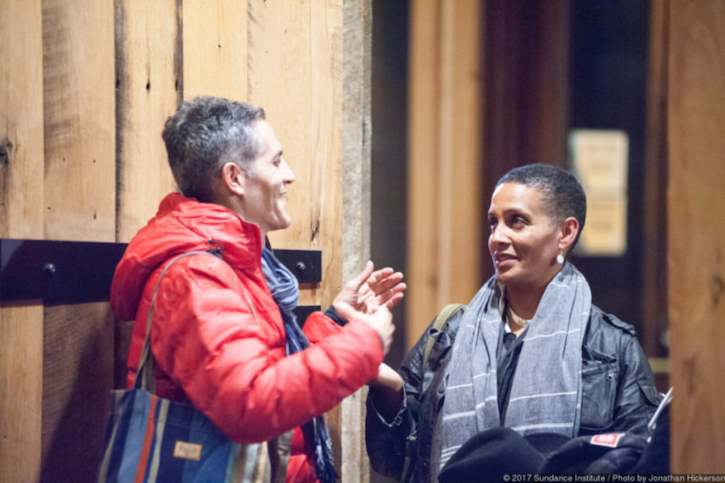 Tabitha Jackson with Sam Green, 2018 Art of Nonfiction Fellow. Photograph by Jonathan Hickerson, courtesy
of the Sundance Institute.
Tabitha Jackson with Sam Green, 2018 Art of Nonfiction Fellow. Photograph by Jonathan Hickerson, courtesy
of the Sundance Institute.
RR
There seems to also be a lot of documentaries being made about celebrities, musicians, and social media influencers. A narcissistic take over of the genre to help “brand.”
TJ
I think it’s fine. We shouldn’t be precious about the form. The form of documentary or nonfiction contains multitudes. It ranges from incredibly expressive, experimental, provocative work to what is referred to as “content” at the other end. You have the instrumental forms of nonfiction or documentary, you have propaganda, advocacy, journalism, you have the poetic and metaphorical, and you have sub-genres like music documentaries or biopics. It’s all there, and to have a job that supports artists as they find a voice to express their experience of the world in all its messiness, beauty, injustice, transcendence, violence, and love is what gets me up in the morning. I work with a fantastic team who are tasked with responding to the needs of artists and their creative process through funding, residential labs, peer-to-peer fellowships, and explorations into other sectors and disciplines. We sum it all up by saying that our aspiration is to create a space for imaginative possibility. We cannot ignore the market because it enables the artists we serve to be sustainable and reach their audiences, but the market is not our primary concern. That will always be the independent voice.
RR
At the risk of getting too in the weeds with semantics, what is the distinction you see between nonfiction and documentary?
TJ
For me, documentary has a fairly specific history which brings with it expectations around what it should and shouldn’t be—and a very proud history of what it has been. This question: “Is it really a documentary?” is one I find quite tedious, and is often the least interesting thing about the film in question. I’ve starting using the term nonfiction because it speaks to a greater breadth of form that is more representative of what is going on now. So yes, there is an incredibly strong and vital strand of documentary filmmaking as we would recognize it. There is also a lot happening on the edges of the form—hybrid forms and films that are not necessarily what we would describe as documentary but can be considered nonfiction or cinema of the real. I often quote this line from David Shields’ book Reality Hunger (2010), “The roominess of the term nonfiction: an entire dresser labeled non-socks.” It could be anything, it’s just not fiction. That’s why our fellowship for bold and expressive film is called “The Art of Nonfiction.”
RR
Part of my resistance to the term nonfiction is when it comes to films that play with hybridity. The term fiction itself indicates something that is made-up, and nonfiction is something that is objectively not real. But I’m less and less interested in objectivity as truth. I feel like we need to allow for a subjectivity of truth, and allow the masquerade of objectivity fall away.
TJ
I totally hear you. We have this discussion at Sundance between the Documentary Film Program and Feature Film Program. The other issue I have is with the word “narrative” to describe fiction films. Documentaries also often have a narrative. Or when people talk about “movies” separately from documentaries. Documentaries are movies as well. Constraining categorizations of documentary are unhelpful. I feel nonfiction is a more capacious term than documentary. I’d started saying “cinema of the real,” but that sounds so incredibly pretentious.
RR
(laugh) I really like cinema of the real. And to add to the pretension of it, I think we should call it “cinema of the ‘real.’”
TJ
Yes! Absolutely. I have conversations with my colleague Michelle Satter who runs the Fiction Feature Film program, and she says that what they do is called cinema of the real as well. What else is more “based on a true story” than taking from real -life. It’s funny because what I’m about to say is almost directly contradicting you. But to me the feel of the word “nonfiction” feels more capacious than documentary. For me, “documentary” asserts some claim to truth. To me, calling something nonfiction rather than documentary is to invite people to ask the question: What is it? I don’t have an easy label for it, I have to ask myself what I’m watching. This is a question often raised in the work of people like Robert Greene and Kitty Green—all the Greens! Sam Green?! Because they show the means of production and play with notions of truth and facticity.
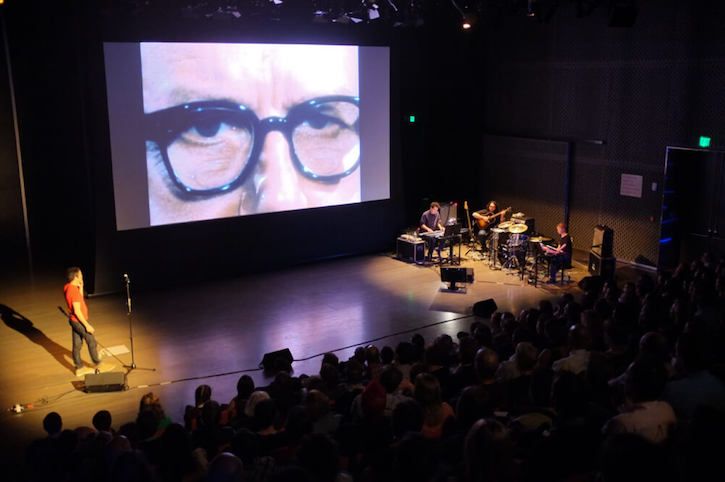 Performance Still, Sam Green, THE LOVE SONG OF R. BUCKMINSTER FULLER (2012).
Performance Still, Sam Green, THE LOVE SONG OF R. BUCKMINSTER FULLER (2012).
RR
Oooo! Let’s talk more about truth and facticity. And how this relates to the trend of journalistic documentaries.
TJ
To me, there are still some irreducible elements. Facts are one of them. In whatever film you’re making, facts need to be checked. We have the responsibility for things we are asserting to be facts, to make sure that they are. To me, truth is a combination of fact plus meaning. And meaning comes through time. And meaning can change over time, and therefore truth can change over time. Facts can’t change over time. Which is why they are unassailable and a different thing than truth. There isn’t a thing called objective reality for me. Reality is made up of an explosion of subjectivities. There is such a thing as an objective fact—it either is a fact or it is not a fact.
RR
I needed to hear this articulation of truth as porous. This is a really critical distinction between truth and fact. Let’s go back to the structures of funding, exhibition, and distribution. Do you think streaming platforms are changing the ways documentaries are being made and engaged with?
TJ
There is a worry I hear about the bottom having dropped out of the acquisition market because of those platforms. But set against that is the fact that the platforms had taken an interest in acquiring nonfiction, which broadly speaking was an absolute bonus for filmmakers and audiences. For filmmakers, because the platforms were hungry for “content,” were pretty hands-off in terms of creative notes and interference, and provided budgets which otherwise would have taken an independent filmmaker two years to raise. And then their work could be released in 192 countries simultaneously, and audiences have access to more work than ever before. All that was fantastic.
RR
What do you think about these platforms creating their own content and films?
TJ
In and of itself it is of course fine, but in terms of the world that I work in, it can once again lead to financial precarity within a middle class of independent documentaries—those that are trying to pull financing together for films that are neither the micro-budget ones, nor the one and a half to two million dollar films which may have a famous person or musician at the heart of them. It invites us to think differently about models of production and distribution—toward a model that is more collaborative. That conversation has been in the ethical and aesthetic realm, but now it feels like we should once again be thinking about it in terms of how films get made and seen. There is also an ongoing discussion in relation to these platforms- about what it does to a filmmaker’s relationship with their audience, for example if they don’t know who the audience is? Or if they can never get data on how many people have watched it, or where they were when they watched it, or how long they watched it for?
RR
How does the exhibition of these films online change the actual function of documentaries—for example if they are viewed more and more on iPhones rather than through a collective, physical experience in a theater? Documentaries have never exactly had massive theatrical releases, but it feels like documentaries are becoming an increasingly private medium.
TJ
Because documentary and nonfiction are so many things, the question of how it is experienced really varies. There are some documentaries that you don’t need to go to a cinema to see, enjoy, and experience. Particularly because of the quality of the screen and the quality of the headphones, the experience can be incredibly rich. Cinema isn’t about the size of the screen, it is about the size of the idea. There’s something about how that is expressed aesthetically that makes it cinematic, rather than how big the thing is. So many different people can watch on a mobile. Sure, it makes me sad when I go to a subway in London now and it isn’t full of people reading books, but people staring at screens. But then I ask myself: what are they watching? If they decide to dip into a documentary first thing in the morning, then that makes me very happy! However, a shared, collective experience amplifies the emotion of the film. It feels very different watching The Act of Killing (2012) in a theater than on your TV or laptop. That’s not because of the size of the screen, it’s because when you’re with other people, there’s something that is happening in the room that is the sum of the people in the room. To come together is such a primal thing. To have a shared experience with people you’ve never met before, around a flickering light—there’s something very powerful about that. There’s also something very powerful about listening to and partaking in conversations that have been stimulated by what you have just seen. That’s what is lost when you watch films of any kind in a solitary way. There’s a dimension of humanity that you’re not experiencing. But I’m not hard and fast on every documentary being experienced in a cinema. Living in LA, there are few things more dispiriting than seeing an incredible film in an empty theater—or more annoying than seeing a great film with people eating popcorn through it and answering their phones. (laughter) But, there are few things more transcendent than seeing a film with an audience and weeping together or laughing together! Particularly in this moment of fractured, polarized discourse and hyper-localization, these acts of connection become even more important when they work.
RR
I’m noticing a rise in journalistic documentary filmmaking, and perhaps that is a part of how, in the aftermath of the 2016 US presidential election, the field of journalism is being forced to reckon with itself and its notions of objectivity and subjectivity. What is your take on this?
TJ
As soon as it feels like documentary is filling the role of journalism is when we should be very worried. I don’t think we as a society have the media literacy, and documentary as a form has chosen not to make it clear whether it is journalistic or not. In other words, there are some films that feel like they are factually accurate, but they are not. I refer you to the works of Werner Herzog. Some of those things that are asserted as facts are facts, and other interpretations of things that are creative interpretations on the part of the filmmaker. That is both one of the joys of the form, and one of the dangers. It’s dangerous because it invites you to question what is real and what isn’t, but also one of the reasons we have to be very careful about asserting that documentary is journalism, because we don’t share that methodology.
I saw on Twitter, someone remarked, “the job of journalism is not to bring a person who believes it is raining together with a person who does not believe it is not raining, and assert that you’ve achieved some journalistic balance. The job of the journalist is to look out the fucking window and find out which one of them is telling the truth.” In an ideal world—which we clearly do not live in—there would be journalism and there would be documentary. And they would be two separate things that compliment each other in how we are describing the world to each other. And ourselves. Documentaries commit acts of journalism, and I think they are more powerful for doing that. What documentaries offer is a deeply subjective way to think about how we understand the world and our place within it. We still have a long way to go to ensure that this subjectivity is a proper explosion that is representative of as many perspectives as possible.
Subjectivity is one thing documentary brings to it, the other thing is time. As Richard Linklater said, “If cinema is a painting, time would be the paint itself.” The time it takes to make the work, relates to my point about meaning. Time is one of the factors that produces meaning. The time it takes to make this work is really important. We’re not chasing the news cycle. There’s something else that happens in the process of creation that adds meaning to it. I would say there is something that happens in the process of watching a feature length documentary that brings meaning to it. Documentary brings time and subjectivity, so those two things are incredibly important. What journalism brings is an objective methodology. It is not necessarily about the journalism being objective, so much as the methodology being objective and rigorous. There is an assumption that if you read something in a newspaper, it was by and large true. You understand which newspapers value factual accuracy and which ones have a political agenda, and which ones are a combination of the two. Having a position doesn’t mean that you are less reliable.
****
Hussain Currimbhoy
(Documentary and VR Programmer, Sundance Film Festival)
Roya Rastegar
What drew you to documentary initially, and what are you excited by in documentary programming right now?
Hussain Currimbhoy
I never looked at documentary and fiction as two separate things. I always responded to the energy of documentaries. When I saw Portrait of Jason (1967, Shirley Clarke), that’s when I started to fall in love with documentaries, and understand how you can say so much with so little. You can traverse a culture, a time and a land, with only a face, using interview techniques, and using your camera in the right way.
Excerpt, PORTRAIT OF JASON, Shirley Clarke (1967).
I remember programming documentaries I loved at Sheffield Doc/Fest. And then people coming to me and saying, “Oh I missed the two screenings of this film, how can I see it?” And then having to wait eight months for a DVD to come out, or waiting for someone to buy it for TV. And sometimes it would just never happen. The film would vanish. Incredible films would just vanish. But now, on streaming platforms, you can get access to them like that (snaps fingers). That, to me, is a dream — especially after busting your butt to make people see documentaries and love them. Instead of having to wait for a year for them to come out when the moment is passed and the story has moved on.
For example, that documentary featuring Hannah Gadsby, Nanette (2018, Jon Olb, Madeleine Parry), hit at the right time and the right moment in American culture especially. And now, it’s having its own cultural moment because of its accessibility. It is a utopia for documentary programming right now compared to a decade ago.
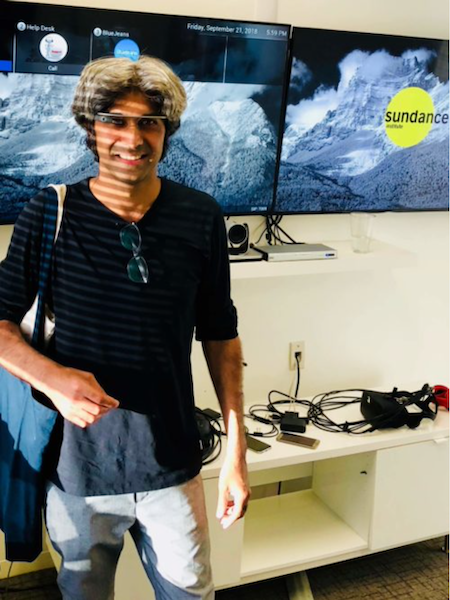 Hussain Currimbhoy wears a Google Glass headset at the Sundance Institute offices in Los Angeles, California. Photograph by Milo Talwani.
Hussain Currimbhoy wears a Google Glass headset at the Sundance Institute offices in Los Angeles, California. Photograph by Milo Talwani.
RR
A lot of the virtual reality (VR) submissions Sundance received last year were pieces that went into war-torn areas.
HC
The pieces from previous years focused on the refugee crisis, or documenting the aftereffects of an attack or displacement, or some kind of trauma on communities. The pieces from this year were much more in the moment. They captured moments when a life was normal, and then was changed forever, like Hero (2018, Navid Khonsari, Vassiliki Khonsari, Brooks Brown).
Hero brought in aspects of performance theater into VR, totally altering your perception of where you are, by onboarding you in a certain way. It’s actually a very simple technique. Then going in blindfolded, onto a stage almost, technicians recreate bombs going off in front of you. It was something I’d never seen before. Alejandro G. Iñárritu’s piece at LACMA CARNE y ARENA (2017) was similar in terms of novelty. Those were two of the best pieces I’ve ever seen in VR because they brought technologies together. They did what we do in traditional feature films: great characters, a clear palette, and a control of the audience’s emotions. Phew! —Hero totally messed me up. I don’t know how they did it. One thing I’ll never forget was the experience I had when walking out of that film: I went to take my headphones off but I couldn’t find my headphones. Then the guide told me I wasn’t wearing any headphones! The sound detail was just so precise. We had watched the demo earlier and thought it was great. But when we saw the finished piece, it was just phenomenal. It actually puts people in a space to make a moral choice. A bomb goes off and you hear someone crying. You can choose to try and save this person, or you can leave—and you have to interact. Your emotions guide the story. There’s no way to avoid that. You have to get involved.
Trailer, CARNE Y ARENA, Alejandro G. Iñárritu (2017).
RR
That’s an interesting point to think about in terms of the role of documentaries up until now. Documentaries bring to the fore truths that we have to see, but also call into question the meaning of those truths by giving you other perspectives. So, VR can take that even further through embodiment. Witnessing isn’t enough with VR—you have to actually move.
HC
Even if you’re a political person, or you think you know what’s happening in Syria, or you think what’s happening there is the right thing, you feel what it’s like to be there. Never mind the other frames that shape the conflict—whether it’s religion or politics—you feel it. That’s the key thing that VR brings that no previous form of media has ever been able to bring. Even with theater, you are still separate from the stage. You’re all sharing the same air, but you’re separate. With VR, you are literally in the same space, sharing the same ground—and that’s very hard to ignore.
RR
What do you say to the argument around access as it relates to VR? The argument is that VR allows for the most elite audience to generate empathy for the most vulnerable people, but the question remains, how does this empathy translate into action when they put their headphones down and walk out. They are able to feel more deeply, but to what end?
HC
Well, yes. One the one hand, this is why I like the streaming revolution. Because we’re paying for it. Not that much money, but we’re paying for it. Whereas, if it was free, we’d be the product. They take from us more than they give back.
RR
When was it ever free, though?
HC
Things on social media are free, they are ad-based. They are never great quality. Streamers offer quality filmmaking that is accessible for a small amount of money. You’re right, though, class does play a part in it. Iñárritu’s piece is a big, expensive installation. Admission cost was $50 if you didn’t have a LACMA membership, and it was booked out for a year. It creates a gap.
RR
But then, maybe those are the people who need to see it?
HC
Well, yes. (laugh) On the one hand you have the Google Cardboard that came out for free, for everyone. It came out in the Guardian, the New York Times, and was accessible to everybody. If you could get to a newspaper, you could watch a VR piece. I actually can’t pinpoint where that VR trend in journalism has gone. Maybe that wasn’t enough. Maybe the VR pieces were just too short? Or maybe we weren’t paying attention to how people are on-boarded or off-boarded.
RR
What do you mean by theatrical as it relates to VR?
HC
That’s the only problem, generally VR is still a very one-to-one thing. A stagehand has to help you experience a VR piece. For New Frontier this year, Shari Frilot put together a VR cinema, with a sync start for everyone. Did you ever do that?
RR
I saw Lynette Wallworth’s Collisions (2016) which premiered at MoMA. It was a sync start, and it was the first time they had ever done anything like that. Raj Roy, the Chief Curator of Film at MoMA, introduced the project as an experiment. There were probably more stagehands than audience members. It was chaotic, but incredibly fun. I enjoyed the piece so much and equally enjoyed watching everyone trying to feel their way through the piece with all their headsets on.
HC
(laughter) Our VR cinema was maybe more streamlined and intuitive, closer to a natural way of how you see a film. To watch people come out and pull their mask off and not have to wait for others to finish their experience, to not have a lag in finding connection—that was the great thing about it. It’s a very short emotional beat you have when you come out of a VR experience and realize what has happened. People were able to connect on that at New Frontier in 2018. I felt that was a moment where VR left behind one of the biggest criticisms, which is that it is intended for only for one person at a time. It is so hard to connect that way. But I think we broke through that.
Excerpt, THE STORY BEHIND COLLISIONS (2016).
RR
And how did that feel? How did the audience feel?
HC
I saw people smiling. I saw people touching each other. I was trying to make an introduction to the filmmakers right after and people were just talking over me. You couldn’t keep them from talking. Like when you see a good movie, it is exactly what you want after a screening.
We had a Q&A right after—now there’s a format that needs to change! There was an inquisitiveness from the audience that you just don’t get when the experience is a one-to-one thing. We had a lot of questions about the production, about the why, about the technology. It hit people differently because they all saw it together.
And yes, it is expensive with the required computers and the headsets. It has a price point that not everyone can access. But everyone expects it to be like the iPhone, in the way the iPhone took over the world in five years. But for me, it’s more like the invention of TV or movies. It took an entire generation for it to permeate culture, and for people to learn how to engage. It took years. We’re just at the start of it being an idea. It will take a minute before VR becomes a brick-and-mortar idea.
RR
That’s an interesting reconsideration of VR—that we are actually laying the foundation for its engagement now, the brick-and-mortar infrastructure of how it will be seen and how it can be iterated. It feels like VR is taking off faster outside the US, in places like Australia or Europe. Why is that?
HC
There are schools now in Australia that have VR courses, open to young people. They have decent funding. There is a ton of openness to risk. The difference in Europe—France and Germany especially—is their investment in the infrastructure of VR, making the technology accessible, making studio spaces accessible, encouraging artists to start up and helping subsidize their work—that’s smart.
This means that you’re getting VR cafés popping up everywhere. I went to one in Nantes, in the west of France. My friend and I were at a café, and he asked me: “You work in VR right? Want to do some VR?” I was so surprised—“There are VR cafes here?” “Yeah, they are everywhere! Want to try one? There’s one right here in the back.” “Uh…yeah, okay. I do this all day, but okay, I’ll give it a shot.” So I went into the back, and they had a computer and a chair and a person there describing how you do it. “Pffff. Yeah, I know how to do it. Come on. I’ll do a kid’s one, for eight-year-olds.” (eye roll, snicker) I thought I would just play a five-minute racing game and be done with it. And an hour and a half later, $100 bucks in, I’m still there. (hyperly nodding) “What else do you have?” I asked. I was loving it. It was a great interactive set up. I loved it.
RR
Like Universal Studios! (laughter)
HC
But in the west of France. It was so much fun. And everyone at the café was just watching me do it.
RR
I love that so much about VR, how you can actually watch people experience it and that becomes part of the experience itself.
HC
That’s part of the fun, exactly.
RR
Do you think there is more funding for a specific kind of projects in VR? Whether they are documentary or fiction? Do you think those categories even apply when we’re talking about VR?
HC
There’s much more of a meld, much more of a crossover. I just came from the studio of the person who made one of the first feature films in VR. He got money to make a fictional VR piece that is shot in 2-D and VR. It could be episodic or a feature-length film. There’s not much of a documentary element, beyond the fact that it’s written by millennial women, has a millennial cast and talks about #metoo, current politics, what it’s like to be alive right now. But this is done with highly staged scenes. So that got money. I think if you can capture the group experience in VR, you’re more likely to get support.
RR
I wonder if ultimately VR will go in a more sensational direction, similar to the kinds of pieces you describe from the café in France, that are more escapist, rather than intellectual.
HC
I don’t know if people who appreciate fine art also like headsets. I don’t know whether there is a big enough audience to have those spaces of VR and documentary converge. I’m hearing about holographic pieces all of a sudden and the idea of taking over a large space like a warehouse to showcase them in. So at festivals, you’re waiting in these long lines, and seeing nothing, and then you put the headset on and see everything, as they say. To avoid that, people are incorporating augmented reality (AR) into their work.
RR
Do you think that will be present more in the future? Augmented reality?
HC
I think for entertainment, social media, and phone calls, it will be VR. To relax, it will be VR. For gaming, the future could be more AR-leaning. The New York Times has an AR experience, where you can go to the cave where those Thai kids were trapped, and you can see the cave as being part of your world.{1} That mixed reality will affect every element of our lives.
RR
What are other changes you’re glad to be seeing in the field of documentary?
HC
What I’m glad about is that the activist documentary is hitting a wall. I think people are much more savvy than filmmakers think. You have to say things with creativity rather than just pushing it in the audience’s face. It doesn’t work sometimes. One of my favorite examples is Forks Over Knives (2013, Lee Fulkerson). There was no context. It’s just bam, bam—facts facts facts. And people can lose faith in the documentary form that way. At the same time, Dinesh D’Souza’s documentaries are like that—terribly, bombastically made, full of diatribes—yet making tens of millions of dollars at the box office. It still works sometimes.
RR
Steve Bannon has a production company, Glittering Steel. He makes documentaries.
HC
And who invented the film festival? Mussolini.
RR
That’s why Cannes was formed.
HC
As a response to that?
RR
Yes, France and Britain were upset because Italy and Germany rigged the jury, they set it up so Olympia won. And they decided to start their own festival, an Olympics of film festivals, where every country could be represented equally. Except, not the Eastern Bloc or the global south.
HC
(Gestures broadly) Everyone is welcome. (Then, sternly) But not all of you.
{1}“Step Inside the Thai Cave in Augmented Reality,” New York Times, July 21, 2018,


